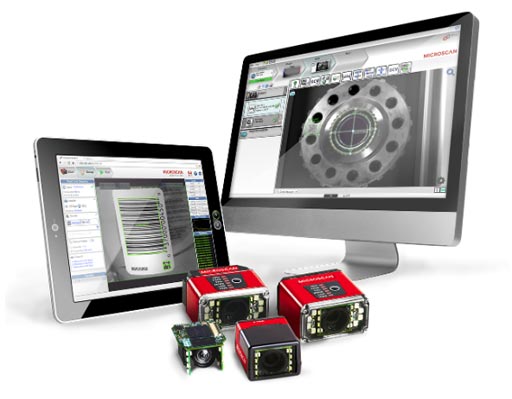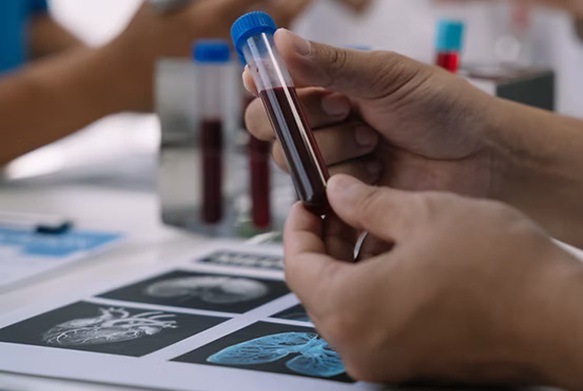Microscan Demonstrates Advanced Technology at Scientific Meeting
|
By LabMedica International staff writers Posted on 01 Aug 2017 |

Image: The MicroHAWK platform for barcode reading and machine vision (Photo courtesy of Microscan Systems).
Microscan Systems, Inc. (Renton, WA, USA), a provider of embedded clinical barcode readers and machine vision solutions for life sciences, demonstrated advancements of its MicroHAWK platform for barcode reading and machine vision, LVS label verification, and print quality inspection systems at the 69th AACC Annual Scientific Meeting & Clinical Lab Expo, the world’s largest exposition for clinical laboratory products and services.
Microscan’s barcode reading, machine vision, and verification technology serves a wide range of automation and OEM applications and the company’s solutions range from barcode reading, tracking, and traceability to complex machine vision measurement, guidance, barcode verification, and print quality grading. The company was among over 750 exhibitors who displayed pioneering diagnostic technology, including the latest in mobile health, molecular diagnostics, mass spectrometry, point-of-care, and automation at the 2017 AACC Clinical Lab Expo held at the San Diego Convention Center from August 1-3.
Microscan’s MicroHAWK platform provides users a single hardware solution with options to meet any barcode decoding or inspection task, in any integration space, and with scalability to meet unique current and future requirements. The hardware has been designed with life science and OEM applications in mind, focused on specific feature customizations in enclosed devices that can be manufactured and supported by Microscan on a long-term basis to accommodate instrument lifecycles.
The company’s miniaturization technology allows medical device manufacturers, laboratories, and OEMs to use MicroHAWK devices in the most space-constrained installations. For instance, the extremely small size of MicroHAWK smart cameras enables them to be easily embedded for automating processes such as specimen and reagent identification, tracking labware presence and absence, cap type and color identification, dimensional measurements such as tube height and diameter, automated alignment and robotic guidance within turnkey medical devices and instruments.
MicroHAWK barcode readers, which were on display at the event, are equipped with Autofocus technology, enabling flexible positioning in medical equipment and other integration environments. MicroHAWK with Autofocus can read symbols at any distance, while fixed-focus models are factory-configured to decode at set focal distances. Autofocus models offer both an automatic autofocus for continuous symbol location and decoding, as well as software-programmable focus - which allows users the option to set fixed focal distances for Autofocus units from Microscan’s Weblink software user interface. Through direct integration of the Autofocus lens technology into MicroHAWK, Microscan eliminates additional cost to the user, minimizes device size, avoids integration complexity and removes the need for additional optical accessories.
Also on display was Microscan’s LVS-9580 Handheld Barcode Verifier - a high-performance handheld solution for off-line barcode verification to ISO/IEC and GS-1 standards. The LVS-9580 reads and analyzes multiple types of linear (1D) and two-dimensional (2D) barcodes up to 3.0 inches (76.19 mm) wide and up to 2.25 inches (57.15 mm) tall, located on a wide range of surfaces. It enables users to test newly designed labels for quality and compliance issues before printing.
Microscan also ran live demonstrations of its LVS-7510 Print Quality Inspection System, configurable into manufacturing lines and printers to check label accuracy on the fly during label printing. It is used for 100% label inspection including 1D/2D barcode verification, OCR, serialization and blemish detection in medical device manufacturing, packaging and other industries. The LVS-7510 identifies errors in code readability and compliance as codes are printed, allowing manufacturers to address printing or formatting issues before incurring fines and scrapped product down the supply chain. Both in-line and off-line verification solutions address the growing need for compliance to the FDA’s Unique Device Identification (UDI) initiative, GS1 and HIBCC data structure, as well as other regulated barcoding and product serialization standards.
Related Links:
Microscan Systems
Microscan’s barcode reading, machine vision, and verification technology serves a wide range of automation and OEM applications and the company’s solutions range from barcode reading, tracking, and traceability to complex machine vision measurement, guidance, barcode verification, and print quality grading. The company was among over 750 exhibitors who displayed pioneering diagnostic technology, including the latest in mobile health, molecular diagnostics, mass spectrometry, point-of-care, and automation at the 2017 AACC Clinical Lab Expo held at the San Diego Convention Center from August 1-3.
Microscan’s MicroHAWK platform provides users a single hardware solution with options to meet any barcode decoding or inspection task, in any integration space, and with scalability to meet unique current and future requirements. The hardware has been designed with life science and OEM applications in mind, focused on specific feature customizations in enclosed devices that can be manufactured and supported by Microscan on a long-term basis to accommodate instrument lifecycles.
The company’s miniaturization technology allows medical device manufacturers, laboratories, and OEMs to use MicroHAWK devices in the most space-constrained installations. For instance, the extremely small size of MicroHAWK smart cameras enables them to be easily embedded for automating processes such as specimen and reagent identification, tracking labware presence and absence, cap type and color identification, dimensional measurements such as tube height and diameter, automated alignment and robotic guidance within turnkey medical devices and instruments.
MicroHAWK barcode readers, which were on display at the event, are equipped with Autofocus technology, enabling flexible positioning in medical equipment and other integration environments. MicroHAWK with Autofocus can read symbols at any distance, while fixed-focus models are factory-configured to decode at set focal distances. Autofocus models offer both an automatic autofocus for continuous symbol location and decoding, as well as software-programmable focus - which allows users the option to set fixed focal distances for Autofocus units from Microscan’s Weblink software user interface. Through direct integration of the Autofocus lens technology into MicroHAWK, Microscan eliminates additional cost to the user, minimizes device size, avoids integration complexity and removes the need for additional optical accessories.
Also on display was Microscan’s LVS-9580 Handheld Barcode Verifier - a high-performance handheld solution for off-line barcode verification to ISO/IEC and GS-1 standards. The LVS-9580 reads and analyzes multiple types of linear (1D) and two-dimensional (2D) barcodes up to 3.0 inches (76.19 mm) wide and up to 2.25 inches (57.15 mm) tall, located on a wide range of surfaces. It enables users to test newly designed labels for quality and compliance issues before printing.
Microscan also ran live demonstrations of its LVS-7510 Print Quality Inspection System, configurable into manufacturing lines and printers to check label accuracy on the fly during label printing. It is used for 100% label inspection including 1D/2D barcode verification, OCR, serialization and blemish detection in medical device manufacturing, packaging and other industries. The LVS-7510 identifies errors in code readability and compliance as codes are printed, allowing manufacturers to address printing or formatting issues before incurring fines and scrapped product down the supply chain. Both in-line and off-line verification solutions address the growing need for compliance to the FDA’s Unique Device Identification (UDI) initiative, GS1 and HIBCC data structure, as well as other regulated barcoding and product serialization standards.
Related Links:
Microscan Systems
Latest AACC 2017 News
- Siemens Healthineers Showcases Atellica Solution at AACC 2017
- Ortho Clinical Diagnostics Highlights Immunodiagnostics at Clinical Expo
- Combating Infectious Diseases Key Focus of AACC
- World's First Fully Integrated LC-MS/MS Clinical Analyzer Unveiled
- Clinical Chemistry Analyzer Provides DAU Screening
- Diatron Displays New Hematology Analyzer at UAE Congress
- AACC Middle East to Be Held in Abu Dhabi
- AACC 2017 Focus on CRISPR and Futuristic Testing Devices
- Opioid Drug Abuse Testing Key Topic at Congress
- Keynote Address to Focus on CRISPR/Cas9 Gene Editing
- Winner of Qualcomm Tricorder XPrize Unveiled at AACC
- Annual Meeting Offers Industry Education and Entertainment
Channels
Clinical Chemistry
view channel
‘Brilliantly Luminous’ Nanoscale Chemical Tool to Improve Disease Detection
Thousands of commercially available glowing molecules known as fluorophores are commonly used in medical imaging, disease detection, biomarker tagging, and chemical analysis. They are also integral in... Read more
Low-Cost Portable Screening Test to Transform Kidney Disease Detection
Millions of individuals suffer from kidney disease, which often remains undiagnosed until it has reached a critical stage. This silent epidemic not only diminishes the quality of life for those affected... Read more
New Method Uses Pulsed Infrared Light to Find Cancer's 'Fingerprints' In Blood Plasma
Cancer diagnoses have traditionally relied on invasive or time-consuming procedures like tissue biopsies. Now, new research published in ACS Central Science introduces a method that utilizes pulsed infrared... Read moreMolecular Diagnostics
view channel
Simple Blood Test Better Predicts Heart Disease Risk
Cardiovascular diseases (CVDs) are the primary cause of death worldwide. A large proportion of these cases could be prevented by addressing lifestyle and environmental factors such as smoking, poor diet,... Read more
New Blood Test Detects 12 Common Cancers Before Symptoms Appear
Bowel cancer is the fourth most common cancer in the UK, with over 42,000 new diagnoses each year. Detecting bowel cancer in its early stages can be challenging, and as the disease progresses, survival... Read moreHematology
view channel
New Scoring System Predicts Risk of Developing Cancer from Common Blood Disorder
Clonal cytopenia of undetermined significance (CCUS) is a blood disorder commonly found in older adults, characterized by mutations in blood cells and a low blood count, but without any obvious cause or... Read more
Non-Invasive Prenatal Test for Fetal RhD Status Demonstrates 100% Accuracy
In the United States, approximately 15% of pregnant individuals are RhD-negative. However, in about 40% of these cases, the fetus is also RhD-negative, making the administration of RhoGAM unnecessary.... Read moreImmunology
view channel
Stem Cell Test Predicts Treatment Outcome for Patients with Platinum-Resistant Ovarian Cancer
Epithelial ovarian cancer frequently responds to chemotherapy initially, but eventually, the tumor develops resistance to the therapy, leading to regrowth. This resistance is partially due to the activation... Read more
Machine Learning-Enabled Blood Test Predicts Immunotherapy Response in Lymphoma Patients
Chimeric antigen receptor (CAR) T-cell therapy has emerged as one of the most promising recent developments in the treatment of blood cancers. However, over half of non-Hodgkin lymphoma (NHL) patients... Read moreMicrobiology
view channel
Handheld Device Delivers Low-Cost TB Results in Less Than One Hour
Tuberculosis (TB) remains the deadliest infectious disease globally, affecting an estimated 10 million people annually. In 2021, about 4.2 million TB cases went undiagnosed or unreported, mainly due to... Read more
New AI-Based Method Improves Diagnosis of Drug-Resistant Infections
Drug-resistant infections, particularly those caused by deadly bacteria like tuberculosis and staphylococcus, are rapidly emerging as a global health emergency. These infections are more difficult to treat,... Read more
Breakthrough Diagnostic Technology Identifies Bacterial Infections with Almost 100% Accuracy within Three Hours
Rapid and precise identification of pathogenic microbes in patient samples is essential for the effective treatment of acute infectious diseases, such as sepsis. The fluorescence in situ hybridization... Read morePathology
view channel
Sensitive and Specific DUB Enzyme Assay Kits Require Minimal Setup Without Substrate Preparation
Ubiquitination and deubiquitination are two important physiological processes in the ubiquitin-proteasome system, responsible for protein degradation in cells. Deubiquitinating (DUB) enzymes contain around... Read more
World’s First AI Model for Thyroid Cancer Diagnosis Achieves Over 90% Accuracy
Thyroid cancer is one of the most common cancers worldwide, and its precise management typically relies on two primary systems: (1) the 8th edition of the American Joint Committee on Cancer (AJCC) or ... Read more
Breakthrough Diagnostic Approach to Significantly Improve TB Detection
Tuberculosis (TB) remains the deadliest infectious disease globally, with 10.8 million new cases and 1.25 million deaths reported in 2023. Early detection through effective screening is crucial in identifying... Read more
Rapid, Ultra-Sensitive, PCR-Free Detection Method Makes Genetic Analysis More Accessible
Genetic testing has been an important method for detecting infectious diseases, diagnosing early-stage cancer, ensuring food safety, and analyzing environmental DNA. For a long time, polymerase chain reaction... Read moreTechnology
view channel
Disposable Microchip Technology Could Selectively Detect HIV in Whole Blood Samples
As of the end of 2023, approximately 40 million people globally were living with HIV, and around 630,000 individuals died from AIDS-related illnesses that same year. Despite a substantial decline in deaths... Read more
Pain-On-A-Chip Microfluidic Device Determines Types of Chronic Pain from Blood Samples
Chronic pain is a widespread condition that remains difficult to manage, and existing clinical methods for its treatment rely largely on self-reporting, which can be subjective and especially problematic... Read more
Innovative, Label-Free Ratiometric Fluorosensor Enables More Sensitive Viral RNA Detection
Viruses present a major global health risk, as demonstrated by recent pandemics, making early detection and identification essential for preventing new outbreaks. While traditional detection methods are... Read moreIndustry
view channel
Cepheid and Oxford Nanopore Technologies Partner on Advancing Automated Sequencing-Based Solutions
Cepheid (Sunnyvale, CA, USA), a leading molecular diagnostics company, and Oxford Nanopore Technologies (Oxford, UK), the company behind a new generation of sequencing-based molecular analysis technologies,... Read more
Grifols and Tecan’s IBL Collaborate on Advanced Biomarker Panels
Grifols (Barcelona, Spain), one of the world’s leading producers of plasma-derived medicines and innovative diagnostic solutions, is expanding its offer in clinical diagnostics through a strategic partnership... Read more






















